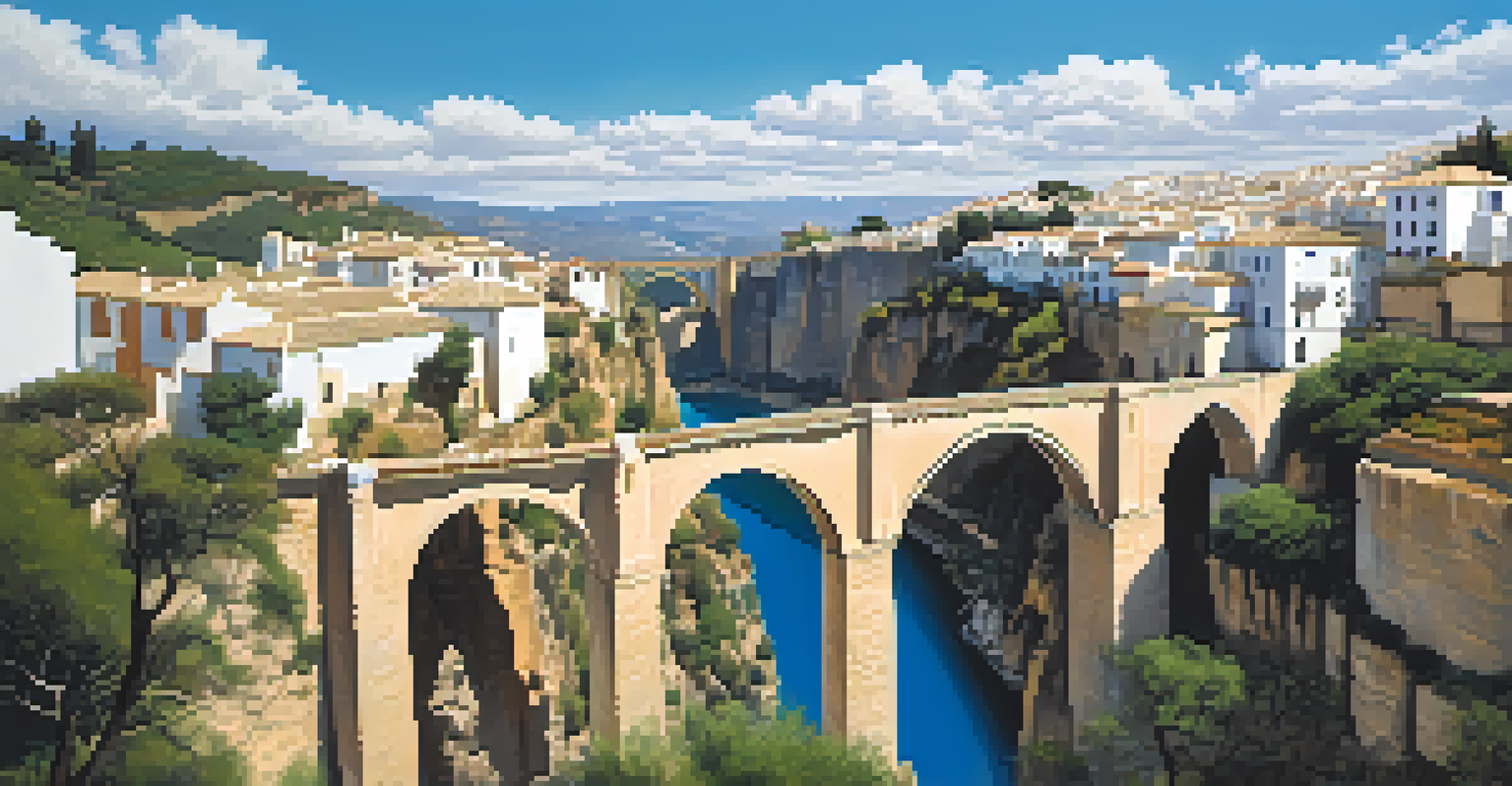Spain's Forgotten Cultural Heritage: Sites Worth Visiting

The Enigmatic Ruins of Empúries: A Glimpse into the Past
Nestled along the Costa Brava, the ancient ruins of Empúries tell a story of Greek and Roman influence in Spain. This archaeological site not only showcases stunning mosaics but also offers breathtaking views of the Mediterranean Sea. As you wander through the remnants of temples and streets, it's easy to imagine the bustling life that once filled this coastal town.
To travel is to discover that everyone is wrong about other countries.
One of the most fascinating aspects of Empúries is how it seamlessly blends different cultures. The ruins include a Greek city founded in the 6th century BC and a Roman settlement that followed. This juxtaposition offers visitors a unique insight into the evolution of lifestyle, architecture, and trade in the region.
If you're looking for a place that combines history with natural beauty, Empúries should be on your itinerary. Visiting at sunset, when the ruins glow in the golden light, provides a magical experience that connects you deeply to Spain's storied past.
The Mysterious Cave Paintings of Altamira: Art in Stone
The Altamira Cave, located in northern Spain, holds some of the world's most significant prehistoric cave paintings. Discovered in the late 19th century, these vibrant depictions of bison and other animals date back around 36,000 years. They represent not just artistry but a glimpse into the lives of our ancient ancestors.

What makes Altamira particularly fascinating is the sophisticated techniques used by its early artists. They employed natural pigments and took advantage of the cave's contours to create lifelike images. Visiting the cave can feel like stepping back in time, allowing you to ponder the thoughts and emotions of those who created this artwork.
Empúries: A Cultural Mosaic
The ancient ruins of Empúries offer a fascinating blend of Greek and Roman history, showcasing the evolution of architecture and trade in Spain.
Although access to the original cave is restricted to preserve its integrity, the nearby museum offers detailed replicas and informative exhibits. This makes it possible for visitors to appreciate the artistry without risking damage to the site, ensuring that these ancient stories live on for future generations.
The Historic Village of Ronda: A Cliffside Wonder
Perched dramatically on a cliff, the village of Ronda is a captivating blend of history and breathtaking scenery. Famous for its stunning Puente Nuevo bridge, which spans a deep gorge, Ronda offers visitors a chance to explore its rich Moorish heritage. The narrow streets are lined with whitewashed buildings that reflect the village's charming character.
History is written by the victors.
Ronda's history is deeply intertwined with the bullfighting tradition, making it a significant cultural hub in Spain. The Plaza de Toros, one of the oldest bullrings in the country, is a must-visit for those curious about this controversial yet integral aspect of Spanish culture. Here, you can learn about the rituals and significance behind the sport, which some see as art while others view it as outdated.
Don't forget to take a moment to enjoy the stunning views from the cliffs that surround the village. Whether you're sipping on local wine or enjoying traditional tapas, the vistas of the mountains and valleys below create an unforgettable backdrop for your exploration of Ronda's rich history.
The Timeless Beauty of the Alcazaba of Almería
The Alcazaba of Almería stands as a testament to Spain's Moorish past, showcasing stunning Islamic architecture and breathtaking views of the Mediterranean. This fortress, built in the 10th century, served both as a defensive structure and a royal residence. Its intricate details and imposing walls whisper tales of the past to every visitor.
Exploring the Alcazaba, you'll notice the intricate patterns and decorative tiles that reflect the artistry of the time. The expansive grounds include beautiful gardens and serene pathways, perfect for a leisurely stroll. Each corner of this historic site invites you to pause and appreciate the craftsmanship that has stood the test of time.
Ronda: History Meets Nature
Ronda captivates visitors with its stunning cliffside views and rich Moorish heritage, highlighted by the iconic Puente Nuevo bridge.
As you ascend to the highest points of the fortress, the panoramic views of Almería and the coastline take your breath away. It's an experience that not only connects you with the region's history but also allows you to appreciate the natural beauty that has captivated people for centuries.
The Unseen Treasures of the Roman Theatre in Mérida
Mérida, the capital of Extremadura, is home to one of the most well-preserved Roman theatres in the world. Built in 15 BC, this remarkable structure still hosts performances today, making it a living piece of history. The theatre's impressive architecture and acoustics showcase the ingenuity of Roman engineering, drawing visitors from around the globe.
Walking through the theatre, you can almost hear the echoes of ancient performances, transporting you back to the time when this venue was the center of cultural life. The intricate details, from the marble seats to the towering stage, reflect the grandeur of Roman entertainment. It's a reminder of how art and culture have always been integral to society.
In addition to the theatre, Mérida boasts a rich array of archaeological sites, including temples and aqueducts. As you explore the city, each site tells a story, inviting you to delve deeper into the fascinating world of ancient Rome and its lasting influence on Spanish culture.
The Unique Architecture of the Roman Aqueduct of Segovia
The Roman Aqueduct of Segovia is an architectural marvel that has stood for nearly two millennia. This impressive structure, built in the first century AD, was designed to transport water from the Frío River to the city. Its striking double tiers of arches create a stunning visual that has become a symbol of Segovia and Roman engineering prowess.
As you walk alongside the aqueduct, you'll find yourself marveling at its sheer size and the precision of its construction. The fact that it has survived centuries of wear and tear is a testament to the skill of its builders. It’s easy to appreciate why this site is designated as a UNESCO World Heritage site.
Santiago de Compostela's Pilgrimage
The Cathedral of Santiago de Compostela serves as a significant pilgrimage site, attracting visitors with its architectural beauty and spiritual importance.
Visiting the aqueduct is not just about appreciating its historical significance but also enjoying the surrounding beauty. The nearby parks and viewpoints offer perfect spots for a picnic or a moment of reflection, allowing you to soak in the history and natural beauty that Segovia has to offer.
The Enchanting Moorish Village of Mijas: A Hidden Gem
The picturesque village of Mijas, tucked away in the mountains of Andalucía, is a perfect blend of charm and culture. Known for its whitewashed buildings and stunning sea views, Mijas offers a glimpse into traditional Andalusian life. The narrow streets are adorned with colorful flowers, creating a postcard-perfect atmosphere that enchants every visitor.
One of the unique features of Mijas is its donkey taxis, a quirky and delightful mode of transport that reflects the village’s charming spirit. Exploring the town on these little donkeys adds a touch of fun to your visit while allowing you to soak up the sights at a leisurely pace. It's an experience that’s both enjoyable and memorable.

In addition to its scenic beauty, Mijas is also home to a number of cultural attractions, including art galleries and historical sites. Don't miss the chance to visit the local pottery shops or the stunning viewpoint at Mirador de Mijas, where you can capture breathtaking photos of the coastline and mountains, making for an unforgettable day.
The Historical Significance of the Cathedral of Santiago de Compostela
The Cathedral of Santiago de Compostela is not only an architectural marvel but also a significant pilgrimage site for Christians worldwide. This stunning cathedral marks the endpoint of the Camino de Santiago, a historic pilgrimage route. Its intricate design and rich history draw visitors from all walks of life, eager to experience its spiritual and cultural significance.
As you enter the cathedral, you'll be captivated by its Baroque façade and the stunning interior, which features intricate chapels and a remarkable altar. The atmosphere is charged with a sense of reverence, as people gather to reflect on their journey and pay homage to Saint James. It's a place where history, faith, and artistry converge.
Beyond its religious importance, the surrounding area is filled with charming streets, lively markets, and delicious local cuisine. Exploring Santiago de Compostela offers a unique opportunity to connect with both the past and present, making it a must-visit destination for anyone interested in Spain's diverse cultural heritage.